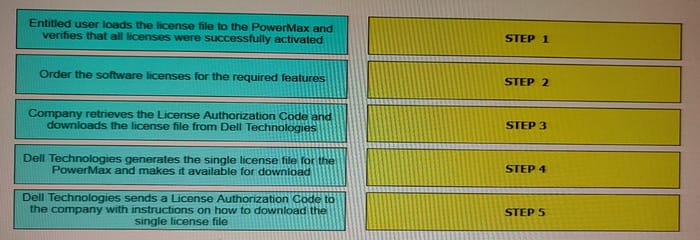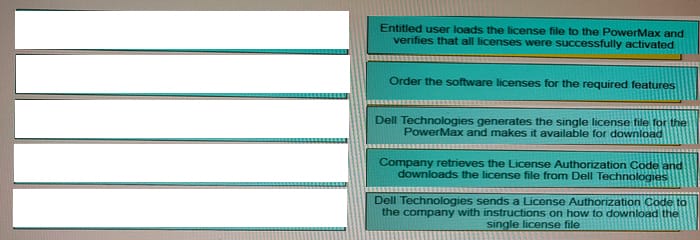DES-1121 Online Practice Questions and Answers
DRAG DROP
What is the correct sequence of steps to obtain PowerMax licenses and ensure the PowerMax is configured to allow the licensed features to work properly?
Select and Place:

DRAG DROP
On a PowerMax what is the correct sequence of steps to deduplicate data?
Select and Place:

A systems administrator plans to use Non-Disruptive Migration (NDM) to migrate data from a VMAX array running Enginuity 5876 to a PowerMax running PowerMaxOS 5978 Which NDM mode will be used?
A. Metro-based
B. Adaptive Copy
C. Asynchronous
D. Pass-through
What does a service level define*?
A. Expected average throughput for a Storage Group
B. Expected average response time target for a Storage Group
C. Expected average response time target for a disk group
D. Expected average throughput for a disk group
A systems administrator is performing a configuration change on a PowerMax array. Where does the configuration manager perform the change?
A. Host which performs the change
B. MMCS
C. Disk drives
D. SYMAPI
What would the RDF device and Link states be after an SRDF Update operation?
A. R1=WD Link=RW. R2=RW
B. R1=RW Link=NR. R2=RW
C. R1=WD Link=NR R2=RW
D. R1=RW Link=RW; R2=WD
Refer to the Exhibit.

Which service levels are available for CKD devices'?
A. Service levels are not used
B. All service levels
C. Diamond, Bronze, and Optimized only
D. Diamond and Platinum only
What is the maximum number of bricks that can be configured on a PowerMac 8000 system bay?
A. 2
B. 4
C. 6
D. 8
What is the maximum number of supported cascaded Storage Group levels in PowerMax and VMAX Family arrays?
A. 1
B. 4
C. 16
D. 64
An administrator is using Unisphere tor PowerMax Workload Planner to assess the performance and compliance of a PowerMax Storage Group (SG) How does the Planner calculate if the Storage Group workload is stable?
A. Both calculated values are within a 10-15% threshold of the SL-defined response time
B. Both calculated values are within the SL-defined response time
C. One of the calculated values remains within the SL-defined response time
D. One of the calculated values is within 10-20% of the SL-defined response time
What will prevent a LUN from being assigned to a second Storage Group?
A. Both Storage Groups have a service level assigned
B. A LUN can only be assigned to one Storage Group
C. Storage Groups are already participating in a Masking View
D. One of the Storage Groups is a child group
You have just presented storage to an ESXi server and want to rescan the storage adapter to ensure the server can see the new volume Based on recommended best practices, what is the preferred method to perform this task?
A. Use the vSphere VSI plugin to rescan the entire cluster
B. Run the command from a non-cluster host using the ESX CLI
C. Use the vSphere Client to perform the rescan of the host
D. Run the command from the ESXi server with the ESX CLI enabled
When listing the details of a snapshot, what does "Total Deltas" reference?
A. Difference between the source and target
B. Difference between the snapshot and the target
C. Difference between the snapshot and the source
D. Difference between the snapshot and a newer snapshot
Which PowerMax software packages include NorvDisruplive Migration?
A. FX and Pro
B. Essentials and Pro
C. F and FX
D. F and Essentials
Which Solutions Enabler daemon is responsible for Oatekeeper management?
A. storapid
B. storsrvd
C. storslpd
D. storgnsd


